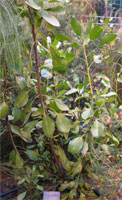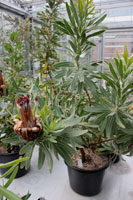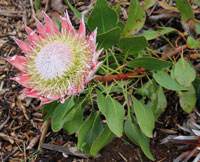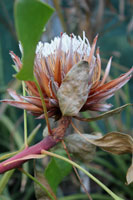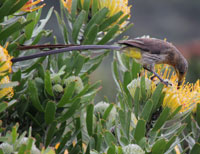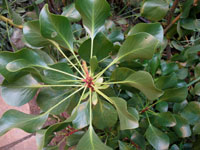|
|
||
This article originally appeared in the Hortus Magazine of December 2016
door Fred Triep
|
The king
protea
is the national flower
of South Africa and the largest
in the Proteaceae
family. |
|
Suikerbossie, 'k wil jou hÍ,
(Afrikaans)
Suikerbossie, 'k zal jou krijg,
Suikerbossie, 'k wil jou hÍ,
Wat sal jou mamma daarvan sÍ?
Suikerbossie,
i
want you,
(English)
Suikerbossie,
i
will get
you,
Suikerbossie,
i
want you,
What will tell your mum
of
it
?
It is no wonder that sugar bossie was a nickname for cute girls,
as in this love song by Fred Michel of 1930: King protea (Protea cynaroides)
or giant protea is one of the most beautiful flowering plants from South Africa.
It is the national
flower of the country.
The genus Protea forms with yet 67
other genera the family Proteaceae.
Linnaeus named this genus in 1735 after the Greek god Proteus, a god who could
change his shape.
The plants from this genus have also a wide variety of forms.
The plants of the Proteaceae family are woody shrubs or trees.
It is a family of about 1250 species, that are found almost exclusively in the
southern hemisphere.
That indicates that the family originated in the continent
Gondwana, which 160 million years ago slowly fell apart in Africa, India,
Madagascar, South America, Australia and Antarctica.
There are two subfamilies.
The subfamily Proteoideae occurs mainly in Africa and the other subfamily
Grevilleoideae is concentrated in Australia and South America.
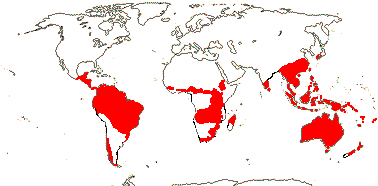
The genus Protea, Sugarbush or Suikerbos called in South Africa, has 101 officially known species. Most species occur mainly in Africa, especially in South Africa. And of those species in South Africa more than ninety percent of them occur in an area around the Cape of Good Hope. The king protea occur in a small area around Cape Town, in the so-called "fynbos". This is a species-rich vegetation of heather plants (Ericaceae), Restionaceae, species from the genus Pelargonium and bulbs (many Iridaceae such as gladioli), where fire occurs frequently in the dry season. Protea species also form part of this vegetation type.
Birds, insects, rodents or the wind
The Protea inflorescence consists of many four-piece flowers, which stand at a woody flower soil and are surrounded by a colored involucre. There is no distinction between sepals and petals like with most flowering plants. What we call a "flower" is actually therefore a compound inflorescence. The construction of the flower resembles that of the Asteraceae (dandelion, daisy, sunflower), where the 'flower' also consists of several small flowers on one flower soil. However, there is no kinship relation between the family Proteaceae and Asteraceae.
The flowers
of the individual petals are fused with
each other at the bottom, but have
free lips at the ends,
on which the
stamens
are attached to the inside. The
stigma of the ovaries of the flowers
protrude from the flower and has
such a shape that pollinating animals have to
touch them. In
the first instance
the stamens give their
pollen to the
stigma's when they are
fertile.
Because the female parts are
only two days later fertile,
in the meantime pollinators
can
transfer pollen to
other flowers. If there
are
any pollinators, then there
can be yet
self-pollination.
Protea kinds of flowers are pollinated by birds, insects, rodents or the wind. In a number of species, including at the koninsgprotea, self-pollination can occur. Probably the king protea is mainly pollinated by birds, among others: the Cape sugar bird (Promerops cafer). This bird has a pointed beak, which he may well collect the nectar that has been produced by the flowers of sugar bushes. Also sunbirds can by sucking the nectar pollinate the flowers. The metallic green Protea beetle (Trichostetha fascicularis) pollinates the flowers because he eat the pollen.
King protea in west Europe?
King protea bushes can grow to two meters high.
The flower
heads may be conical shaped to scale shaped.
The involucre may be hairless or
with fine silky hair.
The colors of the flowers can vary from soft silvery purple to yellow, orange
and red.
Within its distribution area the king protea is very
variable: the leathery leaves vary from large and around to small and narrow.
The individual flowers can be wide open or tunnel-shaped.
There are eighty distinct varieties of this particular Protea
species.
The dimensions of the leaves and the flowers, in general,
shrink from west to east.
The Proteas from South Africa grow in nutrient-poor soil and have irregular
rainfall.
They have adapted to this situation by forming a network of
long sideways growing roots just under the soil
when much precipitation has fallen.
Therefore these plants need hardly be fertilized.
Even after a field fire the king protea can let grow
underground roots
quickly.
Therefore,
this shrub can be pruned vigorously.
Because some forms of this species can endure up to six
degrees of frost, he would with mild winters in the future
also be able to
thrive in the Netherlands
or the United Kingdom.
Large, striking flowers
The king protea bears large showy flowers that do well as cut flowers in
bouquets. The flowers are
long lasting.
The culture of these beautiful flowers is done in
various areas of the world where a Mediterranean climate prevails, as in Western
Australia, South Africa, Israel, the Canary Islands and in the coastal areas of
the states of California and Oregon in the United States.
Although
Protea
species
usually bloom in the spring,
the king protea can bloom all year
round.
The flowering period of the different varieties appears to be genetically determined, so
when moving the plants from their original habitat to elsewhere
there occurs no shift in
the flowering period.
The flowering period is dependent on the habitat of the original habitat
The king protea is located in the Hortus
since years in the subtropical part of the Three
Climates greenhouse of the Hortus, among other South African plants.
As you enter the greenhouse and walk into the small path forward, you
see to the right of the path two plants
of this species.
In this subtropical greenhouse
he has not flourished for years. Probably it is
there still not bright enough.
Gardener Roel have bloom him in the
sunlit greenhouse on the "Overtuin",
the breeding place of the Hortus.
Hopefully it will succeed even in the future in the
subtropical greenhouse.
Literatuur
Koningsprotea- Wikipedia
https://nl.wikipedia.org/wiki/Koningsprotea
Proteas- Wikipedia
http://en.wikipedia.org/wiki/Protea
Protea Atlas Project
http://www.proteaatlas.org.za/
Lewis J. Matthews
The Protea Book-
A Guide to cultibated Proteaceae
Timber Press, Portland, Oregon, 2002
Tony Rebello
A field guide tot he
Proteas of Southern Africa
Sasol,, december 2001
Trichostetha fascicularis- Wikipedia
https://en.wikipedia.org/wiki/Trichostetha_fascicularis
This page was
newly created on
Friday, January 7th, 2017.
![]()
For additional information or comments, please email me:
| Terug naar (return to): | Return to: |


